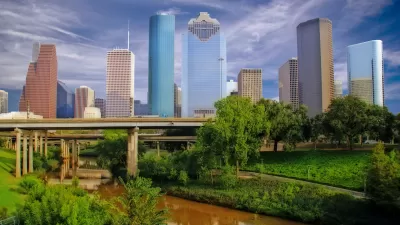Metropolis Magazine examines the 21st century efforts at creating wild places in cities, exemplified by the Buffalo Bayou Promenade in Houston and the Passaic River in Newark.
Writer Karrie Jacobs starts the article by contrasting today’s efforts at creating wild or natural environments in cities with the escapist goals of Olmsted’s Central Park. “What’s happening today is different. Twenty-first century metropolitan nature is about embracing the city, not fleeing it,” says Jacobs. (To be fair to Olmsted's perspective, recent research suggests that a more immersive park experience is necessary to overcome the "cognitive strains" of urban life.)
Jacobs quotes a luminary no less than Robert Hammond, “one of the activists who conjured the High Line into being,” to further that point: “Central Park was meant to be an escape…On the High Line, you’re in nature, but you can hear the traffic; you can see the Empire State Building.”
Jacobs admits that she’s most ”most fascinated by the taming of harsh neighborhood cleavings created by overhead roadways and rail lines,” and identifies the orientation of the High Line, rather than its form or even structures, as the idea most worth emulating in other cities:
“Every city doesn’t need an elevated linear park, nor should every old railroad viaduct be converted for recreational use. But there are features of our cities that we commonly regard as eyesores that should instead be valued as part of our unnatural natural environment. We can find ways to immerse ourselves in these oddities as if they were the uncanny rock formations of some southwestern canyon. Even the most obstructive, no-man’s-land-generating form of urban infrastructure—the elevated expressway—can, with skill and imagination, be incorporated into metropolitan nature.”
FULL STORY: Unnatural Nature

Trump Administration Could Effectively End Housing Voucher Program
Federal officials are eyeing major cuts to the Section 8 program that helps millions of low-income households pay rent.

Planetizen Federal Action Tracker
A weekly monitor of how Trump’s orders and actions are impacting planners and planning in America.

Ken Jennings Launches Transit Web Series
The Jeopardy champ wants you to ride public transit.

Crime Continues to Drop on Philly, San Francisco Transit Systems
SEPTA and BART both saw significant declines in violent crime in the first quarter of 2025.

How South LA Green Spaces Power Community Health and Hope
Green spaces like South L.A. Wetlands Park are helping South Los Angeles residents promote healthy lifestyles, build community, and advocate for improvements that reflect local needs in historically underserved neighborhoods.

Sacramento Plans ‘Quick-Build’ Road Safety Projects
The city wants to accelerate small-scale safety improvements that use low-cost equipment to make an impact at dangerous intersections.
Urban Design for Planners 1: Software Tools
This six-course series explores essential urban design concepts using open source software and equips planners with the tools they need to participate fully in the urban design process.
Planning for Universal Design
Learn the tools for implementing Universal Design in planning regulations.
Heyer Gruel & Associates PA
Ada County Highway District
Institute for Housing and Urban Development Studies (IHS)
City of Grandview
Harvard GSD Executive Education
Toledo-Lucas County Plan Commissions
Salt Lake City
NYU Wagner Graduate School of Public Service





























